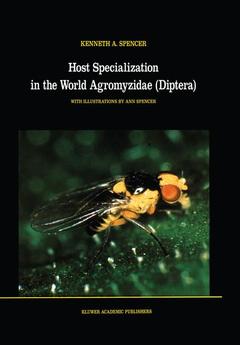Description
Host Specialization in the World Agromyzidae (Diptera), 1990
Series Entomologica Series, Vol. 45
Author: Spencer K.A.
Language: English
Subject for Host Specialization in the World Agromyzidae (Diptera):
Approximative price 316.49 €
In Print (Delivery period: 15 days).
Add to cart
Publication date: 08-2012
444 p. · 21x29.7 cm · Paperback
444 p. · 21x29.7 cm · Paperback
Description
/li>Contents
/li>Comment
/li>
Phytophagous insects represent a very particular not really belong to their host plant range. This may group of organisms. Firstly, their number amounts lead to mistaken conclusions especially in regions to more than one quarter of all recent species (ex where only few observations were possible, as well cluding fungi, algae and microbes) and together with as in the case of uncommon insect species. Fourthly, the green plants on which they feed they form al the great majority (99. 4%) of the agromyzid species most one half of all living species described so far. studied show a high degree of host specialization Secondly, their overwhelming majority shows very which makes these insects especially suitable for narrow host plant specialization, that is they feed taxonomic-phylogenetic considerations. only on one or a few, mostly closely related plant With such an enormous amount of data, it may species, a characteristic that led J. H. Fabre to elab have been tempting to draw far-reaching conclu orate the notion of the 'insects' botanical instinct' a sions. However, the author has been very careful in century ago. doing this.
1. Division BRYOPHYTA.- 2. Divisions EQUISETOPHYTA and POLYPODIOPHYTA.- Class EQUISETATAE.- Class FILICOPSIDA.- 3. Division PINOPHYTA.- 4. Division MAGNOLIOPHYTA (ANGIOSPERMS).- A. Class MAGNOLIOPSIDA (DICOTYLEDONS).- Subclass MAGNOLIIDAE.- Subclass HAMAMELIDAE.- Subclass CARYOPHYLLIDAE.- Subclass DILLENIIDAE.- Subclass ROSIDAE.- Subclass Asteridae.- Order ASTERALES.- B. Class LILIOPSIDA (MONOCOTYLEDONS).- Superorder LILIIFLORAE.- Superorder ARIFLORAE.- Superorder ALISMATIFLORAE.- Superorder BROMELIIFLORAE.- Superorder ZINGIBIFLORAE.- Superorder COMMELINIFLORAE.- Order CYPERALES.- Order POALES.- 5. Polyphagous species.- 6. Concluding remarks: phylogeny, coevolution, colonization.- Taxonomic Appendix.- Acknowledgements.- References.
' Although this is an expensive book, it is well produced and has fabulous colour photograph of black and yellow liriomyz sp. on the cover. Spencer must be congratulated in producing book that will become bible for students of the Agromyzidae and will be widely read by those still to be converted to an appreciation of these most fascinating of files. 'Bulletin of Entomological Research' This is superlative monograph....The drawings...are particularly attractive and useful. One should be extremely grateful for this invaluable combination of world-wide collection, able systematics and plant-host relationships together with the careful assessment of the dat collected.Finally one most congratulate Ann Spencer for her drawings...for once one cam be well satisfied with the Index. Every entomological library, public and private, must quickly obtain copy. 'Antenna, 14:4 1990' This is the first modern monograph of the Agromyzidae that, besides vast number of the host plant data, also critically summarizes all main results of the taxonomic research on this group. It should be useful for those who are intersted in furthur research on the taxonomy and ecology of these insects, and also for appliedentomologists. 'Review of Agricultural Entomology 79:1 1991' This book should be dipped into by entomologists, chemist and botanists alike. It should be on the library shelf of all institutions interested in plant-insect relations. There is nothing else like it ' Kew Bulletin Herbarium 47:1 1992
© 2024 LAVOISIER S.A.S.
These books may interest you

Biology of the Leaf Miners 105.49 €

Scale Insects of Central Europe 210.99 €


